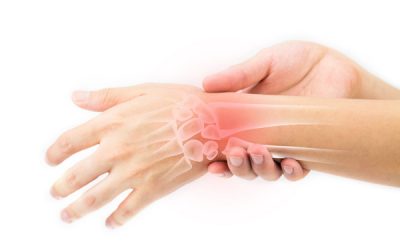Is Important to highlight that the nerves described in all wrist entrapments have the origin at the level of the neck, hence spinal evaluation and treatment should be incorporated when dealing with patients with any wrist and hand neurological complaint.
Carpal tunnel syndrome is a condition that causes an irritation of the median nerve as it passes within the carpal tunnel at the anterior part of the wrist. Patient usually reports with pain on the first three fingers and weakness on the grip function. The main predisposing factor for the developed of this condition, is a compromised wrist arch support narrowing the carpal tunnel and compressing the median nerve. Due to the compromised of the transverse arch, the lunate bone misaligns anterior and can cause a direct irritation on the median nerve.

Carpal-Tunnel-Syndrome-
Ulnar Tunnel Syndrome is a condition that causes an irritation of the ulnar nerve as it passes within the Guyon’s canal at the anterior medial part of the wrist. Patient usually reports with pain on the last two fingers and weakness on the hypothenar muscles causing problems with grip function activities. The main predisposing factor for the developed of this condition, is a compromised wrist arch support narrowing the Guyon’s canal and compressing the ulnar nerve. Due to the compromised of the medial arch, the pisiform bone misaligns medially causing the ligament covering the Guyon’s canal to be pushed down squeezing the ulnar nerve below.

Ulnal-Tunnel-Syndrome
Radial tunnel Syndrome also known as Cheiralgia Paresthetica is a condition that causes an irritation of the superficial radial nerve as it passes over the distal radial bone. Patient reports with pain and the back of the hand on the first three fingers (but not the tips). The main predisposing factor for the development of this condition is a direct irritation of the never by a posterior misaligned distal radial.

Radial-Tunnel-Syndrome
Chronic injuries at the wrist may also narrow the nerve passage due to the scar/fibrotic tissue at the superficial fascia and by the osteophytic bone formation from the underlying bones.
Assessment
The entire upper extremity biomechanical chain must be evaluated as part of the wrist neurological analyses as per the neurological and mechanical influences of the spine, shoulder, and hand.
Clinical assessment of the entire wrist arch alignment support and the corresponding key bones (Distal radial, ulna, scaphoid, lunate and triquetrum)
Neurological Examination
X-ray analysis
Lateral and Anterior – Posterior (AP) X-ray wrist/hand views are essential to check the overall patterns of misalignments and arch compromised.
MRI analysis
Important exam to verify the level of narrowing of the nerve passage and the exact point of irritation
Rule out any other condition; There are rare disorders that may create similar patterns of dysfunction, is advisable to rule out these conditions prior to the start of the treatment.
Treatment protocol
Restore the biomechanical alignment of the wrist and corresponding arch joints supportive system
Neuromobilization techniques may be used once the direct compression of the nerve is reduced.
Specific therapeutic essential oils are applied to reduce nerve inflammation and enhance healing.
Depending on the level of nerve compromised and chronicity of the misalignment a minimum of 6 weeks up to 12 weeks of treatment care may be necessary to resolve this deformity.




